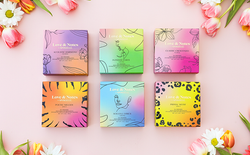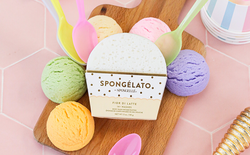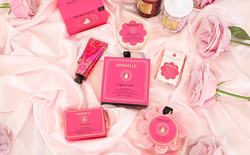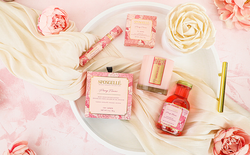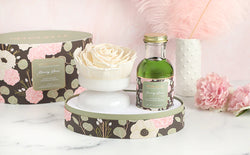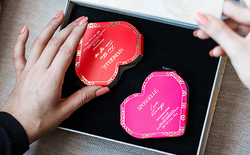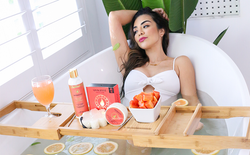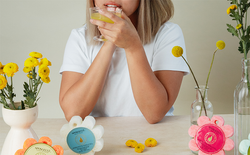A loofah is one of the most popular shower accessories. They help work your body wash into a rich lather to help clean and exfoliate your skin. Loofahs can be made from many different materials, but most traditional loofahs are plastic. These materials are made into a mesh and looped together to create a fluffy ball.
There are several other types of loofahs on the market that don't use plastic. We’re going to go over the complete guide to loofas, from alternatives to traditional loofahs to the risks and benefits of using a loofah. You will also learn how to take care of your shower accessories.
How Loofahs Are Made
As we previously mentioned, most loofahs are made from plastic and contain other synthetic materials. These big plastic poofs are generally bright and colorful.
Natural loofahs use natural materials instead of plastics and synthetics. The most natural loofah comes from the Luffa aegyptiaca plant, also known as the sponge gourd or the Egyptian cucumber.
The fruit of this plant is fibrous on the inside and tubular in shape. When the plant is dried out, it's usually an off-white color. Sometimes people use bleach to make the natural loofah whiter and more appealing. They work the same as a traditional loofah but have a rougher texture. These loofahs can be beneficial when you are exfoliating your body, as well as a more environmentally friendly option than traditional plastic ones.
There are also other sustainable options, like Spongelle’s Spongology Shower With Nature Collection. It’s eco-friendly while still offering a creamy lather. Plus, you won't have to worry about bacterial growth, and it also reduces waste by using minimal packaging!
Loofah Alternatives
Traditional loofahs are not the only bathing accessories available to clean your body. There are many other options if you want to ditch the plastic bath poufs.
Puffer
Spongellé's body buffers are unique bath sponges that are the perfect alternative to a loofah. The sponge is the ideal texture to clean your body. It can work any body wash into a rich lather.
Plus, it's made using a self-preserving formulation that prevents bacterial growth and resists contamination, so you can toss that germ-infested loofah. Try the Apple Blossom buffer for the ultimate pampering experience. This all-in-one beauty treatment will cleanse, exfoliate, massage, and nourish your skin.
Silicone Scrubber
Silicone bath scrubbers also have antimicrobial benefits. The silicone bristles can help you cleanse your skin and gently exfoliate. However, you can't achieve a rich lather like you can with other products.
Sea Sponge
Sea sponges are another natural alternative to loofahs. Similar to the Luffa aegyptiaca gourde, a sea sponge doesn't rely on man-made materials. There are no dyes, chemicals, or preservatives used.
Sea sponges contain some enzymes that kill bacteria, but they still need to be cleaned on a regular basis. You also need to make sure they can dry completely between uses, and you need to replace them frequently.
Washcloth
The trusty washcloth is the O.G. bath accessory used to clean the body. While they are an efficient standby, you can't get the same rich lather with a washcloth that you can with some of the other alternatives.
These are also eco-friendly since you can wash them and reuse them over and over. It’s important to switch them out on a daily basis since they can get funky fast.
How To Use a Loofah
No matter which type of loofah you prefer, the process for using it remains the same. Here’s what you need to know.
Step 1
The first step is to wet your loofah in the shower or bath. Depending on the product, warmer water can make the loofah get softer faster. Don't wet the loofah fully if you really want to get a good exfoliating scrub in.
Step 2
Apply your soap to the loofah. Most people use a body wash, but you can also use a bar of soap by rubbing it over the loofah. You don't need a lot of soap for the loofah to be able to create a luxurious lather.
You can skip this step if you're using one of Spongellé's buffer-infused sponges! The buffer already has body wash inside of it. You just have to get the buffer wet and rub it between your hands to activate the creamy lather.
Step 3
Next, wash your body with the loofah by using gentle circular motions. The motion will help you remove dead skin cells and leave your skin feeling smooth and fresh. You want to scrub firmly enough to clean your skin but not so hard that it leaves your skin red and irritated. Be extra gentle around areas you have sensitive skin, like your underarms.
Start at the top of your body and work your way down to your feet. You can scrub a little harder on the heels and soles of your feet, but be careful not to slip! You also don't want to forget to wash your hands as well.
Step 4
Once you've cleaned all the necessary areas on the front and back of your body, it's time to rinse. Some people like to use cooler water to rinse off because it makes them feel more awake and refreshed. However, warmer water is the way to go if this is a nighttime shower.
Benefits of Using a Loofah
Loofah sponges are a popular option as they’re great scrubbers. Plus, they are easily accessible and pretty inexpensive. Here are a few of the benefits of using a loofah.
- Lather: They can create a rich lather with a small amount of body wash. Although, you can get the same lather from some of the previously mentioned alternatives.
- Exfoliate: Loofahs can exfoliate your body without being too abrasive. The loofah fibers cling to dead skin and dirt to remove it and leave you with smoother skin.
- Blood Circulation: The motion of scrubbing your loofah over your body can stimulate blood circulation. The friction created while washing allows the blood vessels to circulate more blood. You may notice your skin looks flushed, which is a sign of circulation. However, you don't want your skin to be red from scrubbing too hard or using really hot water.
- Cleaning Product: Some people like to use their old loofahs as household cleaning tools. You can use it to scrub your shower, sinks, tile, and other surfaces.
Downsides of Using a Loofah
There are a few downsides to using a traditional loofah. While these products can scrub off dead skin and grime from your body, they can also hold onto dirt and bacteria.
Even when you give it a quick rinse after use and allow it to dry out, it still holds on to impurities and moisture. Bacteria can flourish in this environment, and your loofah can become filled with harmful germs. Scary stuff has even been found in loofahs, like strep bacteria, staph, and E. coli.
Certain loofahs can be too rough on some skin types. If you notice your skin is tender and red, it may be sensitive to exfoliation. You can consult a dermatologist to ask them what's the best product for you to use on your skin.
Plastic loofahs sit in landfills without breaking down. Since they aren't biodegradable, they're there to stay. The microplastics in the loofah can also go down your shower drain and end up in your drinking water. There are plenty of zero-waste products that are better options for the environment.
How To Take Care of a Loofah
It’s important to do more for your loofah than just rinsing it out and hanging it up to dry. If you want to avoid the nasty bacteria that can build up in a traditional loofah, here’s what you need to do.
After showering, rinse the loofah and use a dry towel to wring out the water. This step will help get out a lot of the moisture that would usually stick around. Hang the loofah up in a cool, dry place, which may be outside of your bathroom.
Be sure to clean your loofah every week. Use a mixture of water and 10% bleach to kill bacteria. Allow the loofah to soak in the water for at least 5 minutes. After sanitizing your loofah, rinse it with cool water and allow it to dry out completely before using it again.
You also want to replace your loofah often. The Cleveland Clinic recommends you get a new loofah every three to four weeks. If you notice a musty or mold smell before this, throw it away immediately.
You may also want to avoid using your loofah in your genital area. When you wash with your loofah in that area, your loofah is much more likely to hold onto dangerous bacteria that can sometimes grow there. You also may want to avoid using your loofah on freshly shaved skin. After shaving, your skin can be more susceptible to harmful bacteria.
Final Takeaways
You don't have to deal with many of the issues that come with a traditional loofah when using a Spongellé buffer. They prevent bacterial growth and resist contamination while offering a complete skin care experience. Your buffer will leave your skin smooth and nourished. You'll never want to use anything else!
Quellen:
Luffa aegyptiaca (Loofah, Luffa Sponge, Sponge Gourd) | North Carolina Extension
Coli Infection: Symptoms, Causes, Prevention, Risks & More | Healthline
